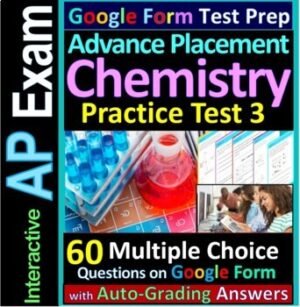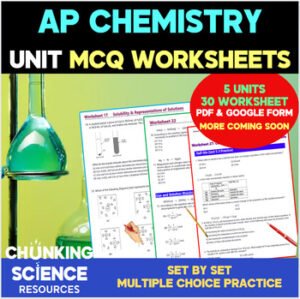Description
Maximum Discount Mega Bundle $aver: This 54-product bundle contains my downloadable/printable lesson-plan resources for teaching, assigning work, reviewing, practicing, and testing in my 13-topic, 61-lesson high school chemistry curriculum. Over 250 resources for a whole year of chemistry planning. These lesson plans are flexible for use with all types of learning; Distance, Virtual, In-person, and Hybrid.
One-stop purchase of all of my downloadable chemistry products with
the maximum discount allowed by TPT.
The 61 lesson plans included in this bundle are listed in the order in which I teach my NYS Regents Chemistry curriculum. Each lesson plan contains a zip folder with resource files listed below. Click on each resource included in this bundle to learn more about the chemistry lesson and to previewit. Thanks.
NOTE: This product is the same as Chemistry Course Plan: 320-Resource Whole Year Mega Hybrid Bundle BUT WITHOUT the almost 70 Googleable or Google Form online resources for this course. Buy this cheaper bundle if you are not assigning work on Google Form.
Approximate Resource Count in This Bundle:
- 250 Individual Resources, including
- 1390 Slides: PowerPoint Teaching Notes (PPT ) ~Editable~
- 300 Pages: Guided Reading (PDF)
- 250 Pages: Essential Skills Homework Worksheets ( PDF)
- 150 Pages: Study Guide/Homework Helper (PDF)
- 85 Activities: Exit Tickets / Task Cards (PDF and DOC, ~Editable~
- 30 Activities: Warmup/Bellringers (mostly vocab terms puzzles)
- 50 Pages: 12 Unit Tests (PDF) ~Editable~
(Scroll down for more info about each resource)
Answer Key included for all questions.
TPT Digital Activity permission is included for creating online and Google Classroom assignments from any PDF resource.
____________ More Info on Each Resource ____________
1. PowerPoint Teaching Notes ~Editable~
- A highly visual, interactive, simply animated PPT notes to teach with.
- Clear bulleted-outline highlights key information students need to know
- Images, diagrams, and tables on most slides help you show and emphasize the key concepts. Provides students with great visual learning.
- Many examples and solutions (if needed)
- Lesson goals and objectives clearly listed at the beginning
- Pop quiz practice questions engage students as you teach. Provide quick assessment of attentiveness and understanding
2. Guided Reading (PDF)
- A super easy to read, learn, and understand guided reading and explanation of key materials
- Key terms are emboldened, simply defined, and further explained for better understanding
- Many colorful images, pictures, diagrams, and tables to support visual learners and boost understanding and memorization
- Many examples, solutions (when needed), and practice questions
- Lesson goals and objectives to start each reading
3. Essential Skills Homework Worksheets (PDF)
- Organized and engaging sets of skill activities.
- Activity sets may include fill-in-blanks, labeling, drawing, multiple-choice, and constructed response questions.
- Easy to assign and assess students’ knowledge and understanding of the materials.
- All multiple choice and constructed response questions are taken from the NYS Regents chemistry test bank.
4. BFF Homework Helper/Study Guide (PDF)
- Bold and engaging summary of all key terms and concepts
- Great for quick study for a test or quiz, or for finding information quickly to a homework question
5. Exit Tickets / Task Cards (PDF and Doc) ~Editable~
- Use as a quick assessment activity for students
- Use after teaching a lesson, before moving on to the next lesson, or before students leave class
- Can be used as a quick quiz, warm-up, or icebreaker assignment
6. Warm-up / Bellringer Activity ~Some are Editable~
- Easy doable activity that gets your students ready for the lesson.
- Mostly a fun word-search vocab puzzle to get your student familiarized themselves with key terms of the lesson.
- It may also be a quick question, diagram label, or graphic organizer activity
7. Unit Test (PDF)
- Cumulative test questions on each of the 12 chemistry topics.
- Each unit test consists of 30 questions from all lessons of the unit
- A mix of highly selective and quality multiple-choice and short answer questions
- Questions selected from NYS Regents chemistry test bank.
Some questions require the use of NYS Chemistry Reference Tables 2011 Edition. Click to access and download.
My Chemistry Curriculum Topics:
Topic 1: Matter, Energy, and Change
- Types and Classification of Matter
- Phases of Matter and Temperature
- Heat and Heat Calculations
- Characteristics of Gases and Gas Law Calculations
- Physical and Chemical Properties and Changes
Topic 2: The Periodic Table
- Properties and Arrangement of the Periodic Table
- Types and Properties of Elements. Metals, Nonmetals, Metalloids, Halogens, Noble Gases
- Periodic Trends
Topic 3: Atomic Structure
- History of Atomic Models
- Structure of an Atom, Atomic Mass, Isotopes
- Arrangement of Electrons
- Neutral Atoms and Ions
Topic 4 Bundle: Chemical Bonding
- Stability and Energy in Bonding
- Types of Chemical Bonds
- Types and Properties of Substances
- Polarity, Shapes, and Intermolecular Forces
- Electron-dot Diagrams
Topic 5: Chemical Formulas and Equations
- Types of Chemical Formulas
- Chemical Nomenclature
- Types of Chemical Reactions and Balancing Equations
Topic 6: Moles and Stoichiometry
- Mole and Mass Calculations in Formulas
- Percent Composition Calculations
- Mole Calculations in Equations
Topic 7: Solutions
- Properties of Solutions
- Solubility Factors of Solutions
- Types of Solutions and Solubility Curves
- Molarity and Parts per Million Calculations
- Vapor Pressure
- Effect of a Solute on the Properties of a Solution
Topic 8: Acids, Bases, and Salts
- Acid and Base Theories and Definitions
- Acid and Base Indicators and pH
- Reactions of Acids and Bases
- Acid-Base Titration
- Relating H+ Concentration to pH
- Salts and Electrolytes
- Naming and Writing Formulas of Acids
Topic 9: Kinetics and Equilibrium
- Reaction Rate, Catalysts, and Activation Energy
- The energy in Chemical Reactions
- Potential Energy Diagrams
- Entropy
- Physical Equilibrium
- Chemical Equilibrium and Le Chatelier’s Principle
- Topic 10: Organic Chemistry
- Properties of Organic Compounds
- Hydrocarbon Compounds
- Functional Group Compounds
- Isomers
- Organic Reactions
Topic 11: Redox and Electrochemistry
- Oxidation Numbers
- Half-reactions: Oxidation and Reduction
- Redox: Oxidation-Reduction Reactions
- Components of Electrochemical cells; Anode, Cathode, Salt Bridge
- Voltaic and Electrolytic Cells
- Activity Series
Topic 12: Nuclear Chemistry
- Nuclear Chemistry Particles
- Nuclear Decay and Reactions
- Balancing and Writing Nuclear Equations
- Half-life
- Uses and Benefits of Radioisotopes
Topic 13: Lab Safety and Measurements
- Lab Safety, Procedures, and Equipment
- Significant Figures
- Reading Measurements and Percent Error










Reviews
There are no reviews yet.